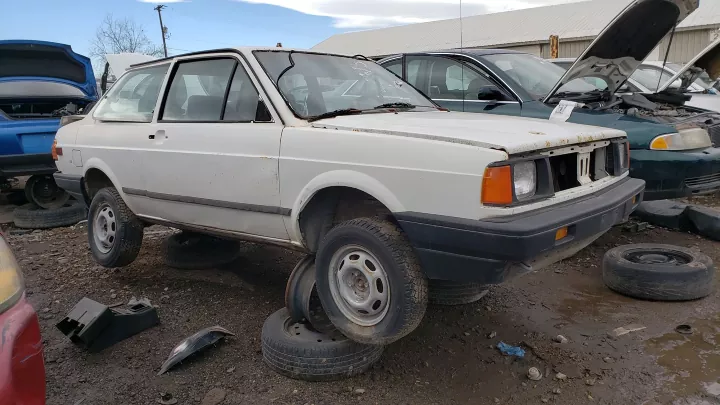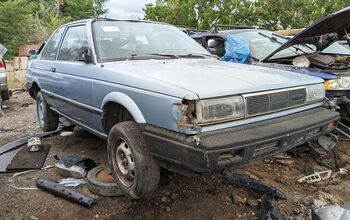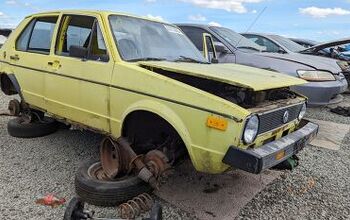1.6K Views
Junkyard Find: 1987 Volkswagen Fox

by
Murilee Martin
(IC: employee)
Published: February 25th, 2019
Share
If you’re a European car manufacturer in the middle 1980s, what do you do when Tercels and Excels and Justys make your value-priced econobox seem too expensive in North America? If you’re Volkswagen, you call up your Brazilian operation and start building Americanized versions of the VW Gol, successor to the Type 1 Beetle in the South American market.Here’s a very early example of the first-year Fox, found in a Denver-area self-service wrecking yard.
The Fox (not to be confused with the Audi-badged version of the early-1970s VW Dasher aka Audi 80 aka Passat, also called the Fox in North America) was sold here for the 1987 through 1993 model years. This one was built in September of 1986 and its production-sequence number (blanked out in this photo) is in the low three digits, so we’re looking at one of the very first Foxes sold.
The odometer reading is low and the interior isn’t too fried by the Colorado sun, so I think this car spent most of its life in a garage. Perhaps it broke a decade or two ago, or maybe its owner had a very short and/or occasional commute. The big analog clock is the kind of luxury feature you’d have never seen on a Toyota Tercel, and it still keeps good time at age 32; naturally, I have added it to my car clock collection.
Power came from the same 1.8-liter four-cylinder engine that went into the base versions of the Golf, Jetta, and Scirocco; the Fox version made 81 horsepower in 1987. Note the fuel distributor for the dreaded CIS fuel-injection system, next to the intake manifold.
Despite the nice clock, this car was one of the cheapest versions of the Fox: a two-door sedan with four-speed manual transmission, scratchy industro-cloth upholstery, and no air conditioning. The MSRP came to just $5,690 in 1987, a steal compared to the $8,190 Golf that year. Meanwhile, the wretched 1987 Hyundai Excel sold for $5,995 and the well-built-but-boring 1987 Toyota Tercel had a $6,548 price tag. The tinny and underpowered Subaru Justy cost $5,725. You could get the early-1970s-technology Chevette for a mere $4,995 that year (yes, GM was still selling Chevettes in 1987), and the best Yugoslavian car in North America could be had for just $4,185 that year.The Fox was more reliable than the Excel and Yugo, more comfortable than the Chevette, slightly less rust-prone than the Justy, and a lot more fun to drive than the Tercel, so it wasn’t a bad deal for its time (though I’d still have bought the Tercel, or a five-year-old Civic).
An interesting bit of Volkswagen history, but even the most diehard North American VW fanatics seem indifferent to Foxes; even after a couple of months in this junkyard’s inventory, few of its parts have been sold.
{
"id": "9183888",
"alt": "",
"title": "",
"video_link": "https://www.youtube.com/embed/6RGAppzD520",
"youtube_video_id": "6RGAppzD520"
}
{
"width": 634,
"height": 357,
"showRelated": true
}
German engineering everyone can afford… again.
{
"id": "9183891",
"alt": "",
"title": "",
"video_link": "https://www.youtube.com/embed/Y8kxKAvxDic",
"youtube_video_id": "Y8kxKAvxDic"
}
{
"width": 634,
"height": 357,
"showRelated": true
}
The Brazilian-market ads were a lot more fun.
#1980s
#1987
#1987VolkswagenFox
#Brazil
#Colorado
#Denver
#DownOnTheJunkyard
#Fox
#Junkyard
#JunkyardFind
#VW
#Volkswagen
#MiserableEconoboxes
#VolkswagenGol
#VolkswagenFox
#VWFox

Murilee Martin
Murilee Martin is the pen name of Phil Greden, a writer who has lived in Minnesota, California, Georgia and (now) Colorado. He has toiled at copywriting, technical writing, junkmail writing, fiction writing and now automotive writing. He has owned many terrible vehicles and some good ones. He spends a great deal of time in self-service junkyards. These days, he writes for publications including Autoweek, Autoblog, Hagerty, The Truth About Cars and Capital One.
More by Murilee Martin
Published February 25th, 2019 8:02 AM
Latest Car Reviews
Read moreLatest Product Reviews
Read moreRecent Comments
- Bouzouki Cadillac (aka GM!!) made so many mistakes over the past 40 years, right up to today, one could make a MBA course of it. Others have alluded to them, there is not enough room for me to recite them in a flowing, cohesive manner.Cadillac today is literally a tarted-up Chevrolet. They are nice cars, and the "aura" of the Cadillac name still works on several (mostly female) consumers who are not car enthusiasts.The CT4 and CT5 offer superlative ride and handling, and even performance--but, it is wrapped in sheet metal that (at least I think) looks awful, with (still) sub-par interiors. They are niche cars. They are the last gasp of the Alpha platform--which I have been told by people close to it, was meant to be a Pontiac "BMW 3-series". The bankruptcy killed Pontiac, but the Alpha had been mostly engineered, so it was "Cadillac-ized" with the new "edgy" CTS styling.Most Cadillacs sold are crossovers. The most profitable "Cadillac" is the Escalade (note that GM never jack up the name on THAT!).The question posed here is rather irrelevant. NO ONE has "a blank check", because GM (any company or corporation) does not have bottomless resources.Better styling, and superlative "performance" (by that, I mean being among the best in noise, harshness, handling, performance, reliablity, quality) would cost a lot of money.Post-bankruptcy GM actually tried. No one here mentioned GM's effort to do just that: the "Omega" platform, aka CT6.The (horribly misnamed) CT6 was actually a credible Mercedes/Lexus competitor. I'm sure it cost GM a fortune to develop (the platform was unique, not shared with any other car. The top-of-the-line ORIGINAL Blackwing V8 was also unique, expensive, and ultimately...very few were sold. All of this is a LOT of money).I used to know the sales numbers, and my sense was the CT6 sold about HALF the units GM projected. More importantly, it sold about half to two thirds the volume of the S-Class (which cost a lot more in 201x)Many of your fixed cost are predicated on volume. One way to improve your business case (if the right people want to get the Green Light) is to inflate your projected volumes. This lowers the unit cost for seats, mufflers, control arms, etc, and makes the vehicle more profitable--on paper.Suppliers tool up to make the number of parts the carmaker projects. However, if the volume is less than expected, the automaker has to make up the difference.So, unfortunately, not only was the CT6 an expensive car to build, but Cadillac's weak "brand equity" limited how much GM could charge (and these were still pricey cars in 2016-18, a "base" car was ).Other than the name, the "Omega" could have marked the starting point for Cadillac to once again be the standard of the world. Other than the awful name (Fleetwood, Elegante, Paramount, even ParAMOUR would be better), and offering the basest car with a FOUR cylinder turbo on the base car (incredibly moronic!), it was very good car and a CREDIBLE Mercedes S-Class/Lexus LS400 alternative. While I cannot know if the novel aluminum body was worth the cost (very expensive and complex to build), the bragging rights were legit--a LARGE car that was lighter, but had good body rigidity. No surprise, the interior was not the best, but the gap with the big boys was as close as GM has done in the luxury sphere.Mary Barra decided that profits today and tomorrow were more important than gambling on profits in 2025 and later. Having sunk a TON of money, and even done a mid-cycle enhancement, complete with the new Blackwing engine (which copied BMW with the twin turbos nestled in the "V"!), in fall 2018 GM announced it was discontinuing the car, and closing the assembly plant it was built in. (And so you know, building different platforms on the same line is very challenging and considerably less efficient in terms of capital and labor costs than the same platform, or better yet, the same model).So now, GM is anticipating that, as the car market "goes electric" (if you can call it that--more like the Federal Government and EU and even China PUSHING electric cars), they can make electric Cadillacs that are "prestige". The Cadillac Celestique is the opening salvo--$340,000. We will see how it works out.
- Lynn Joiner Lynn JoinerJust put 2,000 miles on a Chevy Malibu rental from Budget, touring around AZ, UT, CO for a month. Ran fine, no problems at all, little 1.7L 4-cylinder just sipped fuel, and the trunk held our large suitcases easily. Yeah, I hated looking up at all the huge FWD trucks blowing by, but the Malibu easily kept up on the 80 mph Interstate in Utah. I expect a new one would be about a third the cost of the big guys. It won't tow your horse trailer, but it'll get you to the store. Why kill it?
- Lynn Joiner Just put 2,000 miles on a Chevy Malibu rental from Budget, touring around AZ, UT, CO for a month. Ran fine, no problems at all, little 1.7L 4-cylinder just sipped fuel, and the trunk held our large suitcases easily. Yeah, I hated looking up at all the huge FWD trucks blowing by, but the Malibu easily kept up on the 80 mph Interstate in Utah. I expect a new one would be about a third the cost of the big guys. It won't tow your horse trailer, but it'll get you to the store. Why kill it?
- Ollicat I am only speaking from my own perspective so no need to bash me if you disagree. I already know half or more of you will disagree with me. But I think the traditional upscale Cadillac buyer has traditionally been more conservative in their political position. My suggestion is to make Cadillac separate from GM and make them into a COMPANY, not just cars. And made the company different from all other car companies by promoting conservative causes and messaging. They need to build up a whole aura about the company and appeal to a large group of people that are really kind of sick of the left and sending their money that direction. But yes, I also agree about many of your suggestions above about the cars too. No EVs. But at this point, what has Cadillac got to lose by separating from GM completely and appealing to people with money who want to show everyone that they aren't buying the leftist Kook-Aid.
- Jkross22 Cadillac's brand is damaged for the mass market. Why would someone pay top dollar for what they know is a tarted up Chevy? That's how non-car people see this.













































Comments
Join the conversation
Bernie owned a VW Fox.
I had an '88, 2-dr base. It was a nice car. Coming from an Escort, it was like driving a Bentley. The 4-door GL had a/c and a velour interior which was nicer. Later I owned an '88 wagon which I also liked. They were good cars for me. In fact, I still drive a VW today.